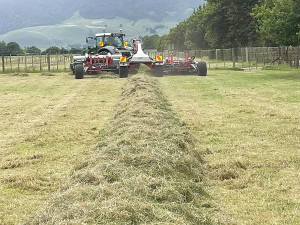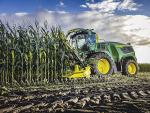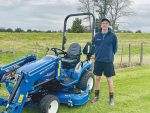Anyone with a hint of grey hair will remember names like Acrobat and Haybob – both machines of the sixties and seventies, designed to gather swathes ahead of small square balers.
As times passed and round bales and bulk silage became more popular, the task of ‘rowing up’ then fell to the likes of single, twin and more lately 4-rotor swathers or rakes.
Today, as self-propelled harvesters climb nearer the 1000hp mark, the need to produce larger swathes to maximise output and slow down forward speeds has become a challenge. Therefore, large-scale operators are looking to the latest innovation, typically in the form of belt mergers.
One such machine, the Austrian-built, Reiter Respiro R9 Profi is imported by Piako Tractors. Despite a hefty price tag, the machine is developing a growing following in the main fodder production areas of the country.
Looking at the machine in detail, the first impression is the general construction uses over-dimensioned components, confirmed by its 6500kg tare weight.
The two pick-up assemblies are each carried on four, hardened boron steel saucers/skids, that working in conjunction with the integral suspension systems only impart between 200 and 300kg ground pressure to ensure there is no damage to the paddock surface
Crops are gently lifted by a small diameter pick up equipped with trailing tines, which ensures no dirt or foreign objects are lifted with the crop. The cam-less design comes with a centre drive that incorporates double bearings. Its tines are cleverly mounted, using a single M8 bolt to fix six double tines. To aid gentle, yet positive crop flow up front, a roller crop press ensures lumps are evened out before a tined rotary feeder delivers the crop to the metre-wide crop conveyors.
Offering multiple delivery strategies, the R9 can be set up for centre or side delivery, twin single or half-sized swaths. In the central delivery mode, a working width of 9m is available to deliver a 1.2m wide swath. Using side delivery, two passes can deliver a cleared width of 15m, three passes 21m, or multiple passes to clear up to 50m.
The twin single swath mode allows night swaths to be set up to avoid heavy dews and the half swath mode is designed to reduce the size of the swath in high volume crops.
Mounted on the tractor across the rear link arms, an oscillating and rotating gearbox mount ensures the PTO shaft always stays straight. The drive is taken to an axial piston hydraulic pump that is fed by a 180-litre reservoir, fitted with an oil cooler.
At the rear of the spine frame, four 550-45 x 22.5 flotation tyres carry the 6400kg machine, working in conjunction with a fourlink kinetic suspension system centred around coil springs. This ensures constant ground pressure and accurate contouring.
Requiring a tractor of around 180hp, with twin double acting remotes and an ISOBUS connection, the machine has a transport width of 2.96m and a height of 3.95m.











